This QuickStart lists all the new and public beta features released, as well as bugs fixed in June 2025.
It is summary in nature, and you should refer to the specific Sigma documentation links provided for more information.
Public beta features will carry the section text "Beta".
All other features are considered released (GA or generally available).
Sigma actually has feature and bug fix releases weekly, and high-priority bug fixes on demand. We felt it was best to keep these QuickStarts to a summary of the previous month for your convenience.
New first Friday features QuickStarts will be published on the first Friday of each month, and will include information for the previous month.
For more information on Sigma's product release strategy, see Sigma product releases
If something is not working as you expect, here's how to contact Sigma support

Azure Canada region
Sigma is now deployed in Azure Canada. Located in Toronto, this deployment gives customers in Canada more control over data storage while enabling compliance with internal policies and external data residency requirements.
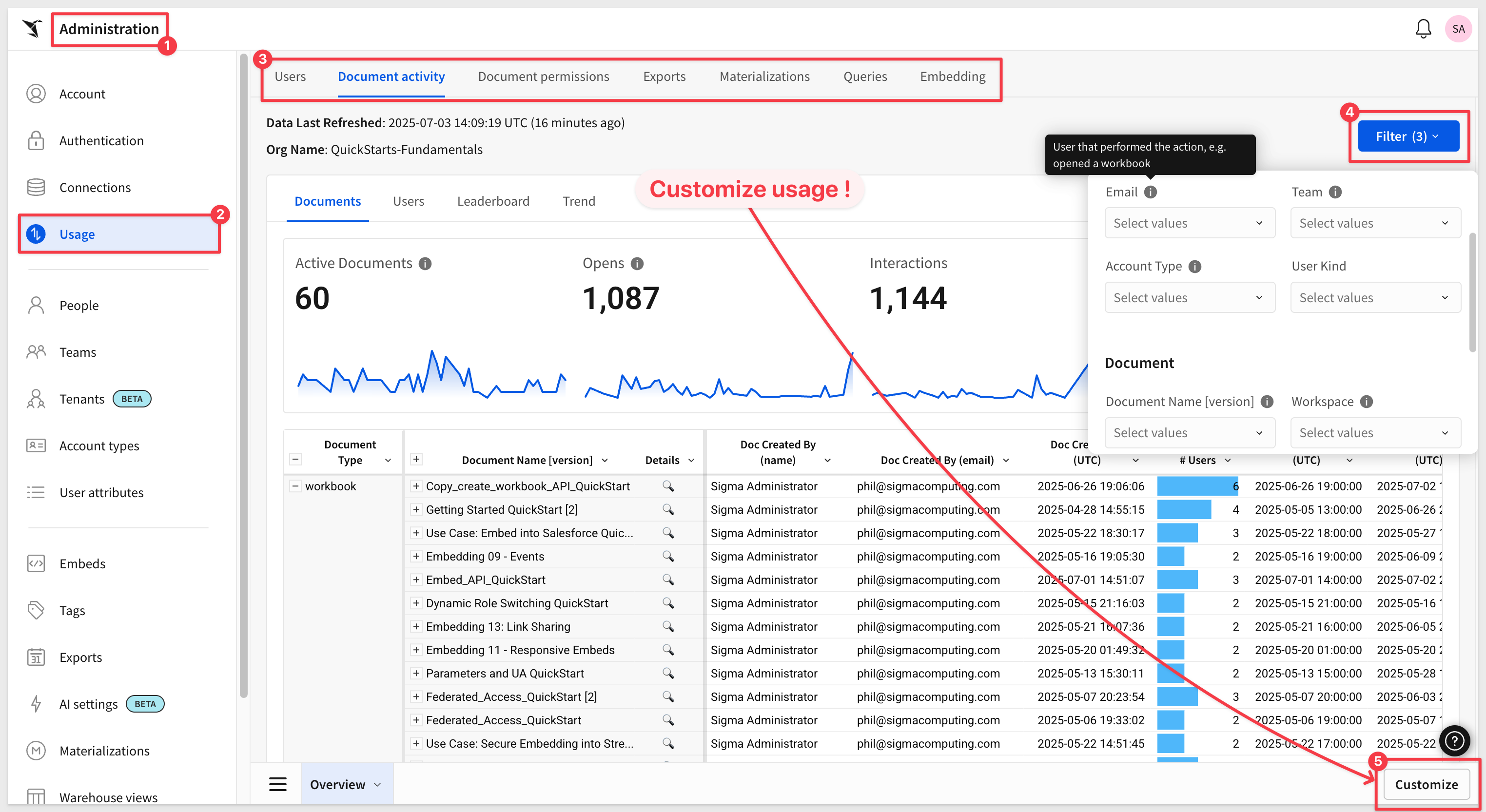
For more information, see Supported cloud platforms and regions
Improved usage dashboards
Usage dashboards have been improved to provide better performance and easier navigation.
To view insights into how your organization uses Sigma and data on your queries, embeds, materializations, and more, go to Administration > Usage.
Just a few of the long list of changes are:
Custom Views:
Users can customize their view of a usage dashboard, save it, and go back to it on their next visit. You can have as many views as you'd like. A view can be simple like saving a customer filter, sorting, or adding a new column. A view can also include adding an entirely new page of visualizations directly against the official Usage data model. You can effectively build and save your own usage dashboards now!
Fresh design:
No more scrolling and searching for filters. Everything has been moved into a tabbed layout and filters are tucked away to reduce clutter.
The latest Sigma features included:
- Tabbed Containers** - Modals - Popovers - Actions
Overall performance improvements
You can also now create and save custom views of your usage dashboards, which allows you to customize the appearance, layout, sorting, and filters of your existing dashboards, or even create new ones of your own.
For more information, see Usage overview
Scheduled Exports for usage dashboards
Related to the effort or overhaul the usage dashboards. usage users can now create their own views/bookmarks, and can also schedule those views.
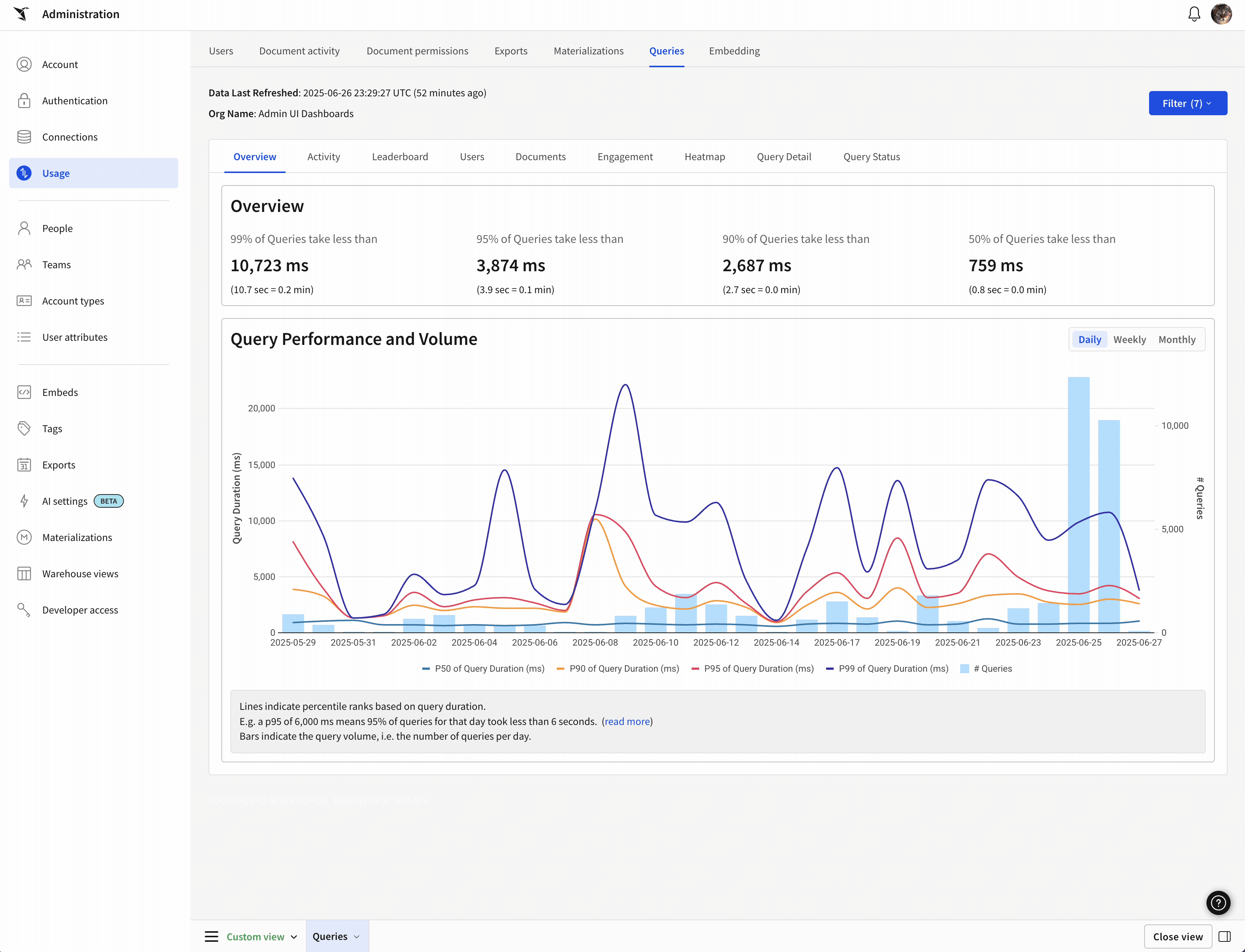
Manage upgrade requests in the Administration portal (GA)
The ability to view and respond to account upgrade requests in the Administration portal is now generally available. When a user requests an upgrade to their account type to explore or create workbooks, an admin can review the request in Administration.
For more information, see Respond to account upgrade requests
User-friendly names for cloud platforms in the Administration portal
Friendly names are now used for cloud platforms in the Administration portal. To view your cloud platform, go to Administration > Account > General Settings, then locate the Site section. The Cloud field identifies the platform hosting your organization:
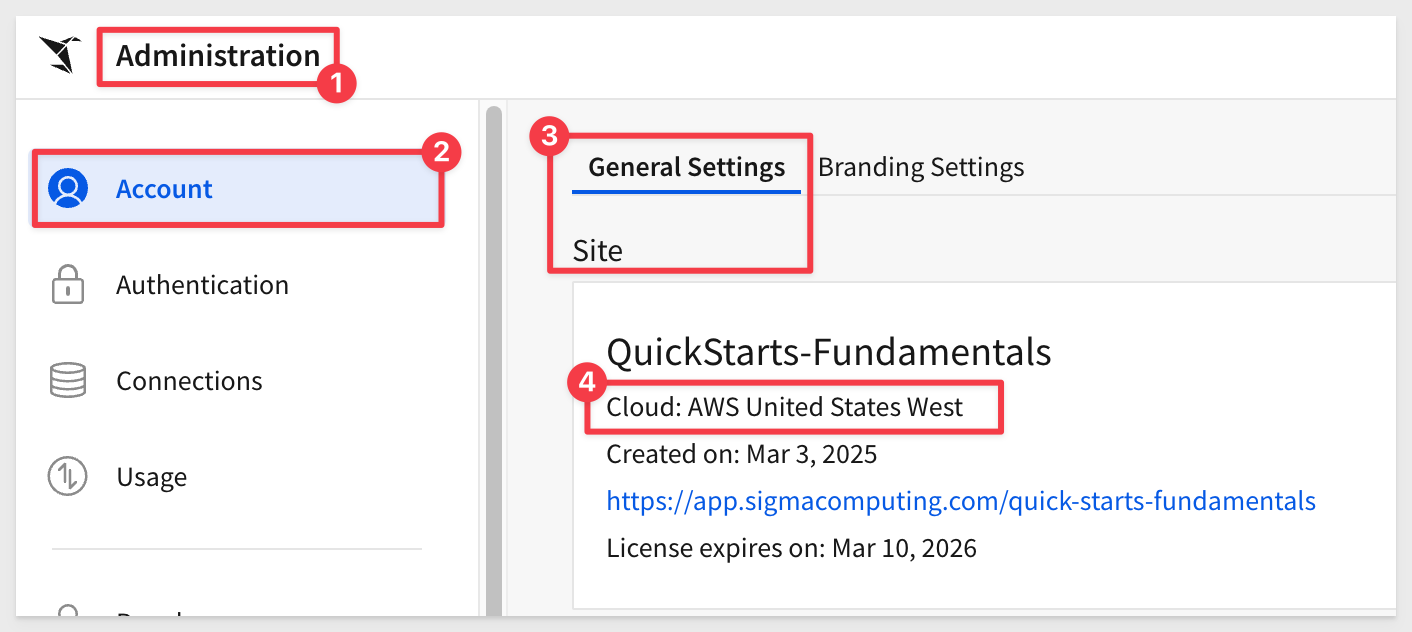
For more information, see Supported regions, data platforms, and features

Configure a usage dashboard for Ask Sigma (Beta)
Admins can now configure a usage dashboard to view data about how Ask Sigma is used in their Sigma organization.
For more information, see Configure a usage dashboard for Ask Sigma (Beta)
There is also a QuickStart: Ask Sigma usage to make it easy to deploy.

API request URLs now visible in the Administration portal
You can now view the base URL required for authenticating to the Sigma REST API in the Administration portal.
Go to Administration > Developer Access:
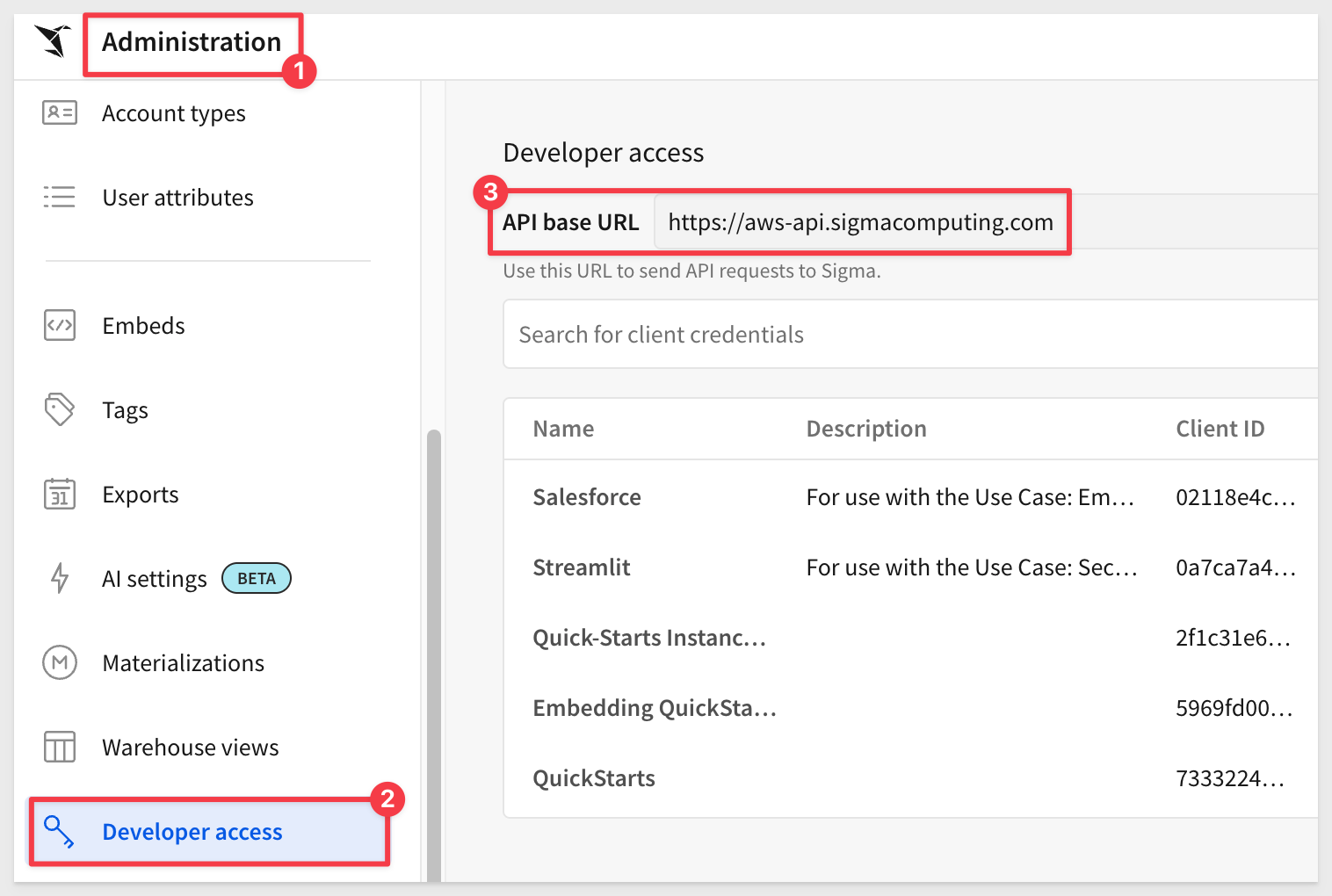
For more information, see Get started with the Sigma REST API
New option for the Create a member API endpoint
When creating a member using the API, choose whether to send an invitation email to a non-embed user.
The Create a member endpoint now includes the sendInvite query parameter:
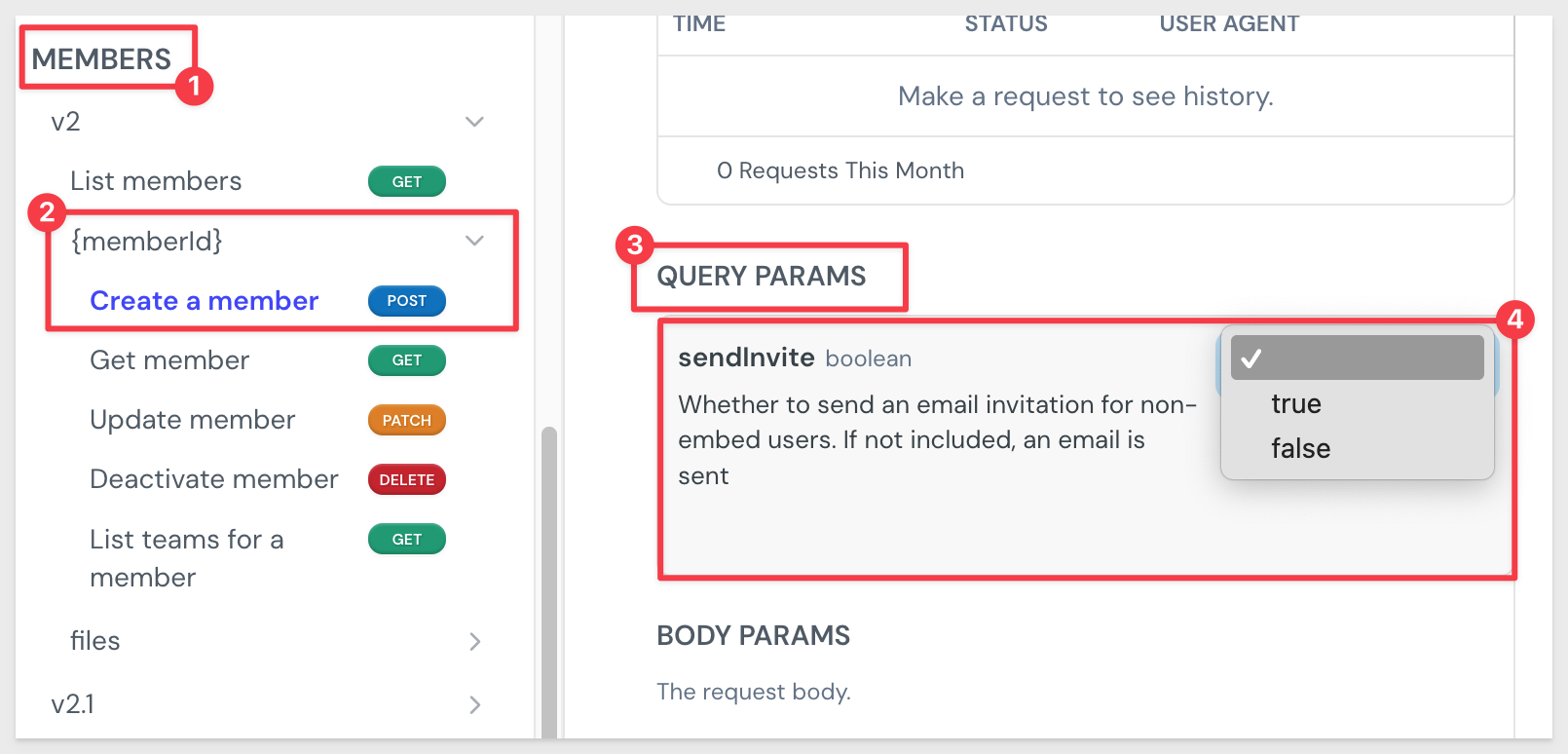
For more information, see Create a member

1: An error where workbook level custom translation files did not show up in workbook settings is now fixed.
2: Plugins now load initial control values as expected on refresh for version 1.0.9 or higher.
3: The workbook header no longer displays an Edit button when viewing a tagged version, which cannot be edited directly.
4: A Return home option no longer appears for users after a secure embed is deleted.
5: After copying and pasting a workbook or data model element with one or more columns that use metrics, those columns display correctly.
6: You can now successfully tag and swap the sources of a workbook version that uses a data model with data from multiple connections.
7: When the signature of a stored procedure used in a stored procedure action is changed, the action now validates that the signature is the same and uses the new signature if possible.
8: When viewing a workbook lineage in an embed, the Shared with me link now launches the embed modal instead of the native Sigma modal.
9: When you disable automatic user creation for embeds, you can now manage embed users in the Administration portal.
10: When Sigma encounters errors during a data source swap involving custom SQL and input tables, Sigma now show the error messages at the bottom of the page.
11: Formulas in action configurations were previously limited to functions supported by all compatible data platforms. You can now use any function supported by your connection's data platform.

Configure data labels per series on Cartesian charts (GA)
If your Cartesian (bar, line, area, or scatter) or combo chart visualizes multiple series of data, you can configure different data label settings for each series.
For more information, see Format and show data labels

Improved data model overview
The status of elements in the model overview panel is more visible when you open a data model for editing but have not yet selected any elements. Elements enabled as a source show with a  icon and elements disabled as a source show with a
icon and elements disabled as a source show with a  icon.
icon.
Improved management of data model source visibility
Instead of managing the visibility of an element in a data model with a  on the element, now you manage the visibility of a table as a source from the Modeling tab.
on the element, now you manage the visibility of a table as a source from the Modeling tab.
For more information, see Enable or disable an element as a data source
Materialization for data models (GA)
Scheduling materialization for elements in data models is now generally available.
If you have data sources that use expensive or long-running queries, such as a complex join between data elements, or a dataset with high cardinality and multiple grouping levels and calculated columns, setting up materialization enhances query performance and can help reduce compute costs.
For more information, see About materialization and Create a data element materialization schedule for a data model or workbook.
Materialization support for version-tagged data models (GA)
Schedule materialization for each tagged version of a data model. If the published version already has a materialization schedule for one or more elements, you can choose to reuse the same schedule for the tagged version.
When you promote a tag to a new version of the data model, such as moving a tag from an older version of the data model to the latest published version, a new materialization run is started. While the materialization runs for the newly tagged version, the materialized data for the previously tagged version of the data model is used.
For more information, see Schedule materialization for a version-tagged data model

Change to email notifications for embed user account type changes
Email notifications are no longer sent to embed users when an admin makes changes to those users' account type.
QuickStart series has been refactored
The entire QuickStart embedding series has been redone to incorporate new embed functionality, sample source code in GitHub, design changes related to horizon and license changes.
Did I mention there are 17 in total!
- Embedding 01: Getting Started - This one anchors them all and needs to be completed first.
- Embedding 02–03: Federated Access, JWTs & Parameters
- Embedding 04: Isolation Solutions
- Embedding 06: Creating a Premium Service
- Embedding 08: Ask Sigma Integration
- Embedding 10: Version Tagging
- Embedding 13–16: Link Sharing, Public Access, React SDK, and more
- Use Cases: Salesforce (using Lightning Web Components), Streamlit
Embedding 05 is missing by design- a placeholder for a new feature coming soon.
New outbound event emitted for saved workbooks
When a workbook is successfully saved using the Save as option from the embed menu, an outbound workbook:saveas event is emitted. The event returns the worbookId of the new workbook.
Developers can use this event to implement custom messages or workflows.
For more information, see workbook:saveas
Removed links to Sigma pages in embedded application workbooks
In embedded applications, Sigma no longer includes links that reference Sigma processes or link to Sigma documentation. Sigma links in these sections of a workbook do not appear in embeds:
- Column details
- Functions bar, specifically the Function icon
- Lineage / query history
- Metric tab

New DayOfYear function and day_of_year DatePart argument
Return the day of the year as a number (1-365, or 1-366 in leap years) from a date using the DayOfYear function.
You can also return the day of the year as a number using day_of_year in the precision argument of the DatePart function.
Three new functions
Sigma has enabled three functions that are useful in any situation where you want to quantify the relationship between two numeric variables, particularly in exploratory data analysis, trend evaluation, or predictive modeling.
RegressionSlope function
The RegressionSlope function calculates the slope of the linear regression line. The function is now supported for Databricks, Snowflake, and PostgreSQL.
For more information, see RegressionSlope
RegressionIntercept function
The RegressionIntercept function calculates the y-intercept of the linear regression line. The function is now supported for Databricks, Snowflake, and PostgreSQL.
For more information, see RegressionIntercept
RegressionR2 function
The RegressionR2 function calculates the R2 value, or coefficient of determination, of the linear regression line. The function is now supported for Databricks, Snowflake, and PostgreSQL.
For more information, see RegressionR2

Input table error handling
The following changes to input tables have been implemented to improve data integrity and prevent unexpected data loss:
- Input table edits that are unsuccessful due to configuration or availability issues in the connection or data platform (which must be resolved by the customer) are now treated as fatal errors and will no longer be retried.
- When Sigma detects a configuration or availability issue in the connection or data platform, it blocks edits to relevant input tables and displays an "Unable to edit" message directly on the input table elements until the configuration issue is resolved.
- Sigma sends admins an email alert that identifies the misconfigured or unavailable connection, displays the error message, and provides troubleshooting guidance.

Create an Ask Sigma Usage Dashboard
In this QuickStart, we explore how to securely enable and monitor Ask Sigma usage in your organization.
Embedding Series Refactoring
The entire QuickStart embedding series has been redone to incorporate new embed functionality, sample source code in GitHub, design changes related to horizon and license changes.
Did I mention there are 17 in total!
- Embedding 01: Getting Started - This one anchors them all and needs to be completed first.
- Embedding 02–03: Federated Access, JWTs & Parameters
- Embedding 04: Isolation Solutions
- Embedding 06: Creating a Premium Service
- Embedding 08: Ask Sigma Integration
- Embedding 10: Version Tagging
- Embedding 13–16: Link Sharing, Public Access, React SDK, and more
- Use Cases: Salesforce (using Lightning Web Components), Streamlit
Embedding 05 is missing by design- a placeholder for a new feature coming soon.

Export to Microsoft Teams and SharePoint (Beta)
You can now export a workbook, workbook page, or element from Sigma to a Microsoft Teams channel or a Microsoft SharePoint folder.
To start exporting to Teams or SharePoint, a user with the Admin account type must set up a Microsoft integration and the relevant account type permission must be enabled for users.
For more information, see Export to Microsoft Teams and Export to Microsoft SharePoint
Export PDFs to larger page sizes (Beta)
When you export a workbook, page, or element to a PDF, you can now choose the page size.
In addition to the previously supported Letter size, you can now export to Legal, Tabloid, A0, A1, A2, A3, and A4 page sizes.
Limit display values in a data element (GA)
Limit the number of values displayed in a grouped table, pivot table, or chart, and group the remaining values in an "Others" category. You can transform an existing column or use the VisibilityLimit function with a sorted table.
For more information, see Limit displayed values in a data element
New supported workbook locales
English (Canada), English (Ireland), Spanish (Mexico) and Chinese (Traditional) are now supported workbook locales. This includes language, date format, number format, and currency. You can preview a workbook in en-ca, en-ie, es-mx, or zh-tw.
For more information, see Manage workbook localization

Additional Resource Links
Blog
Community
Help Center
QuickStarts



